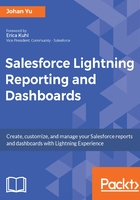
Summary
In this chapter, we started with a discussion on source data, and that a Salesforce report is generated based on the live data in Salesforce. It shows only the data and fields that the user has access to and visibility of. Reports are needed to build dashboards, because each dashboard component needs to have a report to serve as the data source. A dashboard in Salesforce is not auto-refreshed when the user opens it; the user needs to refresh it, or schedule it for a refresh.
We continued with how and where reports and dashboards are stored in Salesforce, that is, folders. We discussed multiple types of folders: private, public, and standard. We also discussed the types of user access levels to the folders.
Next, we learned about permissions, where permission is the basic that controls what a user can do and see in Salesforce, including reports and dashboards. We walked through multiple permissions related to reports and dashboards.
In the next chapter, we will explain how to secure the reports and dashboards created--for your personal usage, or for sharing with your team. We'll also discuss the configurations required to allow a group of all users to have a read access to the report, and allow some members to modify the report.